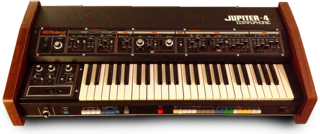
MIDI is a technical standard that describes a communication protocol, digital interface, and electrical connectors that connect a wide variety of electronic musical instruments, computers, and related audio devices for playing, editing, and recording music.

An analog synthesizer is a synthesizer that uses analog circuits and analog signals to generate sound electronically.

CV/gate is an analog method of controlling synthesizers, drum machines, and similar equipment with external sequencers. The control voltage typically controls pitch and the gate signal controls note on-off.

The Roland JX-3P is a synthesizer produced by Roland Corporation of Japan from 1983–1985. The "3P" in its name refers to "Programmable Preset Polyphonic". It is notable as one of the company's first synthesizers to incorporate a MIDI interface.
The Yamaha AN1x is a DSP-based analog modeling synthesizer, produced by Yamaha Corporation from 1997 to 1998, and was marketed as an "analog physical modelling control synthesizer".

The Jupiter-8, or JP-8, is an eight-voice polyphonic analog subtractive synthesizer introduced by Roland Corporation in early 1981.

The Roland Jupiter-4 (JP-4) was an analog synthesizer manufactured by the Roland Corporation between 1978 and 1981. It was notable as the company's first self-contained polyphonic synthesizer, and for employing digital control of analog circuits, allowing for such features as programmable memory, voice assignment modes, an arpeggiator, polyphonic portamento and others.
The Voyetra-8 (Voyetra-Eight) is an eight voice polyphonic analog synthesizer. Released in 1982 by Octave-Plateau Electronics, it was one of the first analog programmable synthesizers to be rack-mountable and remains one of the most flexible digitally controlled analog synthesizers.

The Moog model 2090 Micromoog is a monophonic analog synthesizer produced by Moog Music from 1975 to 1979.
The Korg Poly-61(PS-61) is an analog synthesizer manufactured by Korg between 1982 and 1986. It was the first affordable synthesizer to feature two oscillators per voice, and was Korg's first synthesizer to feature digitally-controlled analog oscillators (DCOs). The Poly-61 marked a significant departure in design philosophy from previous Korg synthesizers by replacing the traditional array of dedicated control knobs on the front panel with a digital interface that required users to select parameters individually for adjustment.

The Doepfer A-100 is an analog modular synthesizer system introduced by German audio manufacturer Doepfer in 1995. Although there were only 10 module types at time of release, it currently has more than 120 modules plus several different enclosures and accessories.
Casio's SDSynthesizers were a late-1980s line of analog synthesizers featuring a resonant filter. SD synthesis was traditional DCO-analog synthesis, with the main difference being that some of the SD waveforms' harmonic spectrums changed temporally, or dynamically in relation to the amplitude envelope.

The Oberheim Xpander is an analog synthesizer launched by Oberheim in 1984 and discontinued in 1988. It is essentially a keyboardless, six-voice version of the Matrix-12. Utilizing Oberheim's Matrix Modulation technology, the Xpander combined analog audio generation with the flexibility of digital controls logic.

The Roland MC-4 MicroComposer was an early microprocessor-based music sequencer released by Roland Corporation. It could be programmed using the ten key numeric keyboard or a synthesizer keyboard using the keyboard's control voltage and gate outputs. It was released in 1981 with a list price of US$3,295 and was the successor to the MC-8, which in 1977 was the first microprocessor-based digital sequencer. Like its predecessor, the MC-4 is a polyphonic CV/Gate sequencer.

The Split-8 is a polyphonic analogue keyboard synthesizer manufactured by Sequential Circuits. Built in Japan and going by the alternative name Pro-8 in some markets, this was one of the last synthesizers produced by the company and was assigned model number 608. It was released in 1985 at a list price of $1,199. This and some other Sequential Circuits synthesizers were built around the Curtis Electronics CEM 3394 "synth-on-a-chip" integrated circuit, and used a Z80 as their central microprocessor.
The Roland MKS-80 Super Jupiter is a rack mount sound module version of the Roland Jupiter-6 and the Roland Jupiter-8 synthesizers. It is an 8-voice polyphonic analog synthesizer that was manufactured by Roland between 1984 and 1987. It is the only one of the MKS series of synthesizers to have analogue voltage-controlled oscillators (VCOs) instead of analogue digitally-controlled oscillators (DCOs). The voice architecture is almost identical to the Jupiter-6 synthesizer. The service manual states that "The module board of MKS-80 features the following in addition to that of JP-6, its brother module. 1) HPF. 2) Low boost circuit in the 2nd VCA. 3) DC supply current boost circuit (IC50)."

The AX60 is a polyphonic analogue keyboard synthesizer manufactured by Akai Professional in the mid-1980s. It was Akai's answer to the popular Roland Juno series synthesizers. The AX60 uses voltage-controlled analogue oscillators and filter circuitry based on the Curtis Electronics CEM 3394 integrated circuit.
Media-accelerated Global Information Carrier (MaGIC) is an audio over Ethernet protocol developed by Gibson Guitar Corporation in partnership with 3COM. It allows bidirectional transmission of multichannel audio data, control data, and instrument power.

The Roland System 700 was a professional monophonic modular synthesizer for electronic music manufactured by the Roland Corporation and released in 1976 and was followed by the Roland System-100M in 1978.

The Volca Bass is an analogue bass synthesizer manufactured by the Japanese music technology company Korg. It was released in April 2013 alongside the Volca Keys and Volca Beats.















